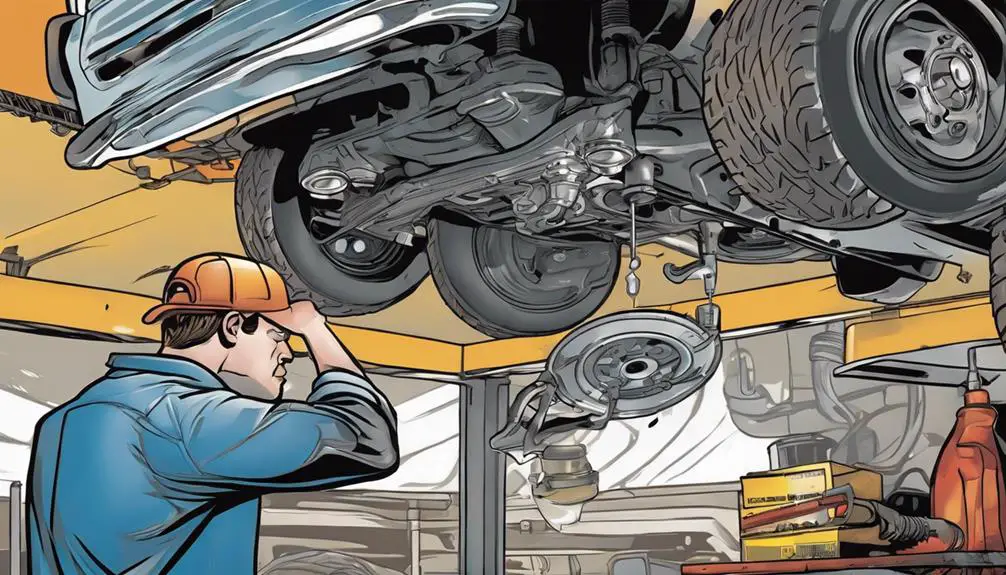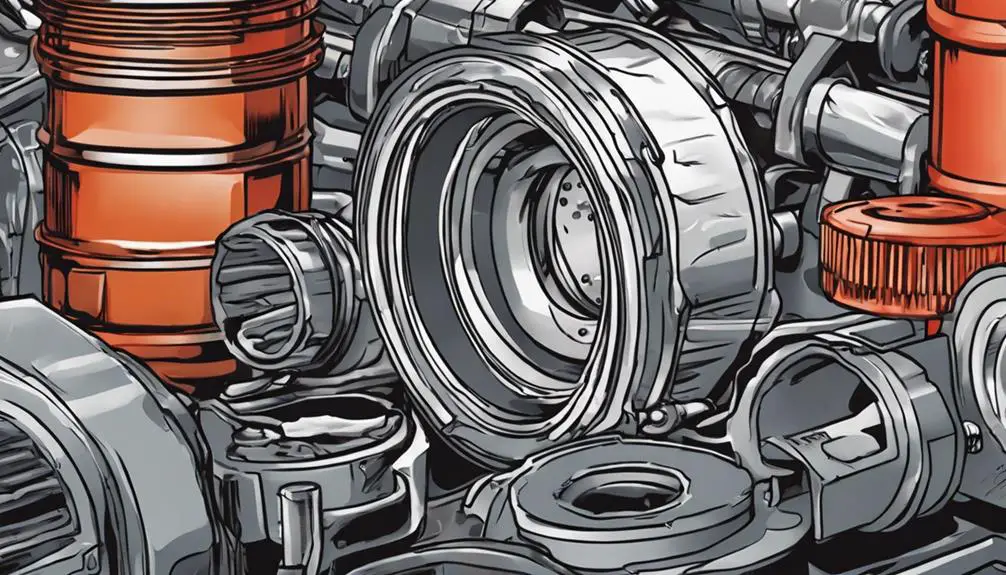When it comes to your Ford F150, did you know that detecting an oil leak early can save you from costly repairs down the road? Understanding the subtle signs and employing expert tips for pinpointing the source of the leak can be instrumental in maintaining your vehicle's health. By mastering the art of spotting oil leaks efficiently, you can potentially avoid major setbacks and guarantee your Ford F150 stays in excellent condition.
Key Takeaways
- Check under the truck for oil stains and drips.
- Inspect oil pan, gasket, and valve cover for leaks.
- Use UV dye for precise oil leak detection.
- Monitor oil levels and consumption regularly.
- Address oil leaks promptly to prevent damage.
Common Leak Symptoms
If you notice a puddle of oil under your Ford F150 or smell burning oil, these are common leak symptoms to be aware of. Pay close attention to any drops or spots of oil on the ground where you park your truck. The presence of oil can indicate a leak in the engine or other components.
Additionally, if you catch a whiff of burning oil while driving or after parking your vehicle, it could be a sign of an oil leak that's dripping onto hot engine parts.
Another symptom to watch out for is a noticeable decrease in your oil levels. If you find yourself needing to top off your oil more frequently than usual, there may be a leak causing the loss of oil. Keep track of your oil levels regularly to monitor any significant changes.
Visual Inspection Techniques
To detect an oil leak in your Ford F150, start by checking under the truck for any visible signs of oil. Look for oil stains on the ground or any components underneath the vehicle.
Make sure to inspect the oil pan for any signs of leakage or damage.
Check Under Truck
Begin your inspection by getting down on the ground and visually examining the underside of your Ford F150 for any signs of oil leakage. Look for any wet spots, drips, or puddles forming beneath the engine area or along the transmission and differential. Check the oil pan, oil filter, drain plug, and the area around the valve cover gasket for any visible oil seepage. Inspect the oil cooler lines and connections as well.
Make sure to also examine the front and rear axles, as well as the driveshaft and transfer case if applicable, as leaks can occur in these areas too. Take note of any accumulation of dirt and grime along the undercarriage, as oil leaks often attract these particles. Pay close attention to any rust or corrosion, as they may indicate a persistent oil leak that needs immediate attention.
Once you have thoroughly checked under your truck for oil leaks, proceed to the next step of looking for stains on the engine and components.
Look for Stains
Inspect the engine and its components for any visible stains that could indicate potential oil leaks on your Ford F150. Look for dark, greasy spots or puddles under the engine area, especially around the valve cover gaskets, oil filter, oil pan, and drain plug. These stains might appear fresh or accumulated over time, depending on the severity of the leak. Pay close attention to the areas where different components meet, as leaks often occur at these junctions.
Examine the engine from the top as well. Check around the valve covers, timing cover, and oil filler cap for any signs of oil seepage or dripping. Sometimes, oil leaks can be spotted on the engine block or cylinder head surfaces.
Inspect the areas around hoses and connections for oil residue, as they could be potential leak points too.
Inspect Oil Pan
You frequently spot oil leaks in the oil pan by visually inspecting it for signs of oil residue or drips. Begin by parking your Ford F150 on a flat surface and allowing the engine to cool down.
Crawl under the vehicle with a flashlight and inspect the oil pan, which is located at the bottom of the engine. Look for any visible signs of oil seepage, such as wet spots, drips, or puddles of oil accumulating on the pan. Check around the edges and the drain plug for any oil residue that could indicate a leak.
Additionally, examine the gasket or seal between the oil pan and the engine for any signs of damage or wear. If you notice any oil buildup or leaks, it's essential to address them promptly to prevent further damage to your vehicle's engine.
Regularly inspecting your oil pan can help you catch leaks early and save you from costly repairs in the long run.
Check Undercarriage for Drips

Scan the undercarriage of your Ford F150 for any signs of oil drips to identify potential oil leaks. Start by parking your truck on a clean, level surface and letting it sit for a few hours.
Afterward, slide under the vehicle and carefully inspect the underside for any wet spots or oil stains. Look for fresh, shiny drips that could indicate an active leak. Pay close attention to the area around the oil pan, oil filter, and drain plug, as these are common sources of leaks in Ford F150 trucks.
Additionally, check the transmission and differential for any signs of oil leakage, as they can sometimes be mistaken for engine oil leaks. If you notice any dripping or pooling of oil, addressing the issue promptly is crucial to prevent further damage to your vehicle and ensure peak performance.
Regularly checking the undercarriage for oil drips can help you catch potential leaks early and save you from costly repairs down the road.
Use UV Dye for Tracing
To further pinpoint the source of an oil leak in your Ford F150, consider utilizing UV dye for tracing potential leaks. UV dye is a fluorescent liquid that can be added to the engine oil. As the dye circulates through the system, it will escape through any leaks along with the oil. Once the UV dye is in place, a UV light is used to illuminate the dye, making it easily visible under the light.
By inspecting the engine and surrounding components with the UV light, you can quickly identify the exact location of the oil leak.
Using UV dye for tracing oil leaks is a convenient and effective method, especially when leaks aren't readily visible. It helps in detecting leaks in hard-to-reach areas or those hidden behind other components. This technique saves time and effort by providing a clear indication of where the leak is originating from, allowing for targeted repairs.
Remember to follow the manufacturer's instructions when using UV dye and light for tracing oil leaks in your Ford F150.
Inspect Oil Pan & Gasket

Consider examining the oil pan and gasket for signs of oil leaks in your Ford F150. The oil pan is located underneath the engine and is responsible for holding the engine oil. Over time, the oil pan can develop cracks or corrosion, leading to oil leaks. Inspect the oil pan carefully for any visible signs of oil seepage, such as oil stains or drips accumulating under the pan.
Next, focus on checking the oil pan gasket. The gasket forms a seal between the oil pan and the engine block to prevent oil from leaking out. If the gasket becomes worn out or damaged, oil can escape and create leaks. Look for any oil residue around the edges of the oil pan where the gasket is located. Additionally, pay attention to any oil pooling around the oil pan gasket area.
Regularly inspecting the oil pan and gasket for leaks can help you catch any issues early and prevent potential damage to your Ford F150's engine.
Check Valve Cover for Leaks
When checking for oil leaks on your Ford F150, don't forget to inspect the valve cover. This component can develop leaks over time, leading to oil seepage.
Keeping an eye on the valve cover is essential for detecting and addressing any potential issues promptly.
Valve Cover Inspection
Inspect the valve cover of your Ford F150 to check for any potential oil leaks. Begin by locating the valve cover, which is typically situated on the top of the engine. Look for any visible signs of oil seepage or dripping around the edges of the valve cover.
Check the bolts securing the valve cover in place to verify they're tight and not contributing to any leaks.
Next, examine the gasket that seals the valve cover to the engine. Look for any signs of wear, damage, or deterioration that may be causing oil to escape. A damaged gasket can lead to oil leaks, so it's important to replace it if necessary.
Additionally, inspect the PCV (Positive Crankcase Ventilation) valve and hose connected to the valve cover. Any cracks or leaks in these components can also result in oil leaks. Make sure these parts are in good condition and properly connected.
Regularly checking the valve cover for leaks can help prevent oil from escaping and causing potential harm to your Ford F150's engine.
Oil Leak Detection
To detect oil leaks in your Ford F150, start by checking the valve cover for any signs of seepage or dripping. The valve cover is a common area for leaks to occur due to gasket failure or loose bolts.
Begin by inspecting the valve cover gasket for any visible cracks, tears, or breaks. Look closely around the edges of the valve cover where it meets the engine to see if there's any oil residue or pooling. Sometimes leaks may be small and only manifest as oil residue buildup, so make sure to thoroughly examine the entire valve cover surface.
Additionally, check the bolts securing the valve cover in place to make certain they're tight and not causing any gaps that could lead to leaks. If you notice any oil pooling, dripping, or signs of seepage around the valve cover, it's crucial to address the issue promptly to prevent further damage and maintain your Ford F150's performance.
Evaluate Oil Filter Area

Check for any visible signs of oil leakage around the oil filter area. Inspect the area where the oil filter is attached to the engine. Look for oil drips or wetness that could indicate a leak. Sometimes oil can accumulate around the oil filter housing, leading to a visible pool of oil below it. Use a flashlight if needed to get a better view of the oil filter and surrounding components.
Ensure the oil filter is properly tightened. If the oil filter is loose, it can cause oil to leak out. Check if the oil filter is securely in place and not over-tightened or cross-threaded, which can also lead to leaks.
In some cases, the oil filter gasket may be old or damaged, causing oil to seep out. If the gasket is worn out, it should be replaced to prevent further leakage.
Monitor Oil Consumption
You should regularly monitor the oil consumption of your Ford F150 to detect any abnormalities or changes over time. Keeping track of how much oil your vehicle is using can help you identify potential issues such as leaks, burning oil, or engine problems.
Start by checking your oil levels at regular intervals, ideally when the engine is cool and parked on a level surface. Keep a record of how often you need to top up the oil and how much oil is being added each time. A sudden increase in oil consumption could indicate a problem that needs to be addressed promptly.
Additionally, pay attention to any signs of excessive exhaust smoke, unusual engine noises, or changes in fuel efficiency, as these can also be indicators of abnormal oil consumption. By monitoring your Ford F150's oil consumption closely, you can catch potential issues early and prevent more significant problems down the road.
Frequently Asked Questions
Can Oil Leaks in Ford F150 Be Caused by Other Fluids?
Yes, oil leaks in Ford F150 vehicles can sometimes be caused by other fluids. Identifying the source of the leak accurately is key.
Transmission fluid or coolant leaks can sometimes be mistaken for oil leaks due to their similar appearance. It's important to inspect the fluid to determine its origin correctly.
If you suspect a leak, consulting a mechanic for a thorough diagnosis and proper repairs is recommended.
How Often Should I Check for Oil Leaks in My Ford F150?
You should regularly check for oil leaks in your Ford F150 to keep your engine running smoothly. Imagine your truck as a well-oiled machine that needs proper care.
Make it a habit to inspect for leaks every time you fill up gas or before a long trip. By doing this, you can catch any issues early and prevent more significant problems down the road.
Are Oil Leaks in Ford F150 Common in Specific Model Years?
Oil leaks in Ford F150s can vary in prevalence across specific model years. Remaining attentive and regularly inspecting for leaks is crucial to catch any issues early.
Keep an eye out for common areas where leaks tend to occur, such as around the oil pan, valve cover gaskets, or oil filter housing.
Can a Small Oil Leak in a Ford F150 Lead to Major Issues?
A small oil leak in your Ford F150 can snowball into major issues if left unattended. Like a pebble causing ripples in a pond, neglecting this minor leak could lead to engine damage, decreased performance, and costly repairs down the road.
It's essential to address oil leaks promptly to maintain your truck's health and prevent more significant problems from surfacing. Be proactive in addressing any signs of leakage in your Ford F150.
What Should I Do if I Suspect Multiple Leak Sources in My Ford F150?
If you suspect multiple leak sources in your Ford F150, it's essential to address them promptly. Start by visually inspecting the engine and undercarriage for any signs of oil leaks.
Tighten loose fittings and replace damaged gaskets. Monitor the oil levels and regularly check for leaks to prevent more severe issues down the line.
Don't hesitate to seek professional help if needed for proper diagnosis and repairs.
Conclusion
So, next time you suspect an oil leak in your Ford F150, remember to check for common symptoms like oil puddles and burning oil smell.
Use visual inspection techniques, such as checking under the truck for drips and using UV dye for tracing.
Don't forget to inspect the oil pan, gasket, and valve cover for leaks.
By monitoring oil consumption and detecting leaks early, you can prevent costly damages and keep your truck running smoothly.
Just like Sarah from Texas, who saved hundreds of dollars by fixing a small oil leak before it turned into a major issue.
